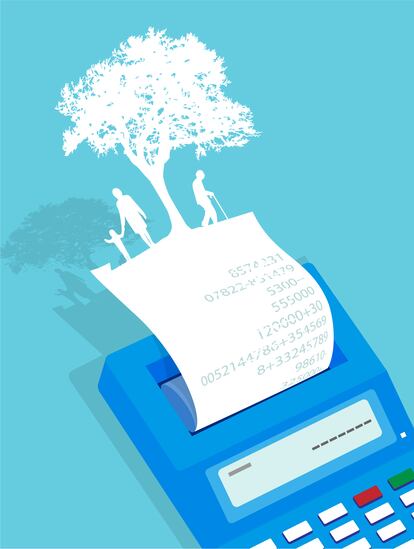Fiscal space at the time of Covid-19
For now, fiscal policy must continue to prop up activity as much as possible, with the decisive support of monetary policy

The best illustration of recent economic events is likely a painting by the Belgian surrealist painter Rene Magritte with a graph of the collapse of GDP and the phrase “this is not a recession.” Because what we are experiencing is not a standard recession, but something truly extraordinary, unique, unrepeatable. Recessions are the culmination of excesses, be it an inflationary overheating that ends with rate hikes, or the bursting of an investment or financial bubble. The excess is gradually reabsorbed, which requires time and a certain reallocation of resources, since there are activities that were only viable at levels of euphoria that were not sustainable. The economy is different after the recession.
What we are experiencing is not the culmination of an excess. It is an induced economic coma, applied by the urgent need to control the coronavirus. And, as such, it has compressed the time dimension of the economic slowdown. What in a recession would happen during several quarters has happened in a few weeks. The US recession may be both the deepest since the Great Depression and the shortest in history. And, if economic policy acts fast and smartly, the economy need not be that different when it wakes up from the coma.
In this upside-down world, the concept of fiscal space, and the relationship between fiscal and monetary policy, are also different
It is, in many ways, the world upside down. During normal recessions, the objective of economic policy is to stimulate consumption and investment without interfering with the process of eliminating excesses. During this induced economic coma the goal is survival. Incomes must be guaranteed without stimulating consumption, at least initially, since everything is closed. Businesses must be supported as much as possible to minimize the destruction of productive capital. Labor relationships must be preserved as much as possible to reduce the length of unemployment. The government, with transfers, subsidies and guarantees, and the central bank, with liquidity, must act as insurers of last resort. The more these economic discontinuities are avoided, the less destruction of productive and labor relationships, the faster and with fewer consequences the economy will recover from the coma.
In this upside-down world, the concept of fiscal space, and the relationship between fiscal and monetary policy, are also different. One of the most popular phrases of the last decade, which also resonates a lot these days, is that “there is no fiscal space.” But, what is fiscal space?
Let’s start with what is not. Fiscal space is not just the level of the deficit or of debt/GDP. Just look at Japan. Let’s not forget that economic theory does not define an optimal, or maximum, level of public debt. Fiscal space is a flow concept and depends mostly on the prospects for growth and interest rates. And interest rates depend on inflation expectations, bond demand, and the perception of fiscal risk. Weak inflation and stronger demand for bonds, in part due to population aging and a generalized increase in risk aversion, allow for low interest rates. The perception of fiscal risk depends, above all, on the quality and coherence of each country’s economic policies. Fiscal risk declines if countries design smart spending policies and efficient tax structures, and if populism is sidelined while productivity growth is promoted.
The concept of monetary financing of the deficit becomes blurred when interest rates are zero and the central bank must act to keep long-term interest rates low
Furthermore, when interest rates are zero and inflation is low, fiscal and monetary policy should be better coordinated. The concept of monetary financing of the deficit becomes blurred when interest rates are zero and the central bank must act to keep long-term interest rates low. In the US, the Federal Reserve is buying bonds, for now, in unlimited quantities, while its Chairman, Jerome Powell, said a few days ago, in an interview with the prime-time television program 60 Minutes, that the possible consequences of not borrowing and spending enough now were that “there could be longer-run damages to the productive capacity of the economy and to people’s lives.”
The time for fiscal discipline will come, no question, and will require a gradual and credible medium-term adjustment plan. But only when the economy has healed and without losing sight of the risk of hysteresis. For now, fiscal policy must continue to prop up activity as much as possible, with the decisive support of monetary policy, until the evolution of the virus makes it possible to fully reopen the economy, thus ensuring that this economic coma doesn’t create permanent damage. Here is the paradox: the more active and better designed the fiscal effort is now, the less damage there will be to potential growth and, therefore, the lower the medium-term fiscal risk. Fiscal space is not fixed, it depends on the decisions that are adopted every day.
Twitter: @angelubide
Tu suscripción se está usando en otro dispositivo
¿Quieres añadir otro usuario a tu suscripción?
Si continúas leyendo en este dispositivo, no se podrá leer en el otro.
FlechaTu suscripción se está usando en otro dispositivo y solo puedes acceder a EL PAÍS desde un dispositivo a la vez.
Si quieres compartir tu cuenta, cambia tu suscripción a la modalidad Premium, así podrás añadir otro usuario. Cada uno accederá con su propia cuenta de email, lo que os permitirá personalizar vuestra experiencia en EL PAÍS.
¿Tienes una suscripción de empresa? Accede aquí para contratar más cuentas.
En el caso de no saber quién está usando tu cuenta, te recomendamos cambiar tu contraseña aquí.
Si decides continuar compartiendo tu cuenta, este mensaje se mostrará en tu dispositivo y en el de la otra persona que está usando tu cuenta de forma indefinida, afectando a tu experiencia de lectura. Puedes consultar aquí los términos y condiciones de la suscripción digital.
More information
Archived In
Últimas noticias
From digital curfews to blocking apps: How technology experts protect their children online
Why the price of coffee has skyrocketed: from Brazilian plantations to specialty coffee houses
Confined to a Cuban hospital: When electricity is a matter of life or death
Half of Scotland is in the hands of 420 property owners
Most viewed
- Pablo Escobar’s hippos: A serious environmental problem, 40 years on
- Reinhard Genzel, Nobel laureate in physics: ‘One-minute videos will never give you the truth’
- Why we lost the habit of sleeping in two segments and how that changed our sense of time
- Charles Dubouloz, mountaineering star, retires at 36 with a farewell tour inspired by Walter Bonatti
- The Florida Keys tourist paradise is besieged by immigration agents: ‘We’ve never seen anything like this’









































